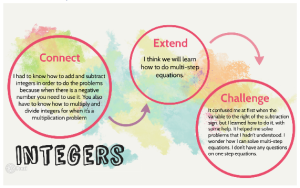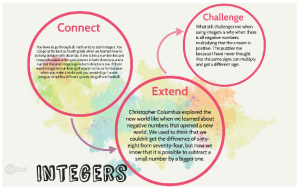Unit Goals and Objective
1. Understanding Integer multiplication and division rules
2. Multiply and divide integers
3. Being able to use in a real life situation
Background and Rationale
The students will learn about how to multiply and divide integers as they review absolute value, adding integers, and subtracting integers. From there they will go on to learn about one step equations. The student will have access to lessons that have been taught online, and there will be extra problems provided for students that need more practice; the steps for the process will be given to them in their notes, and anchor charts, collaboration, conferring and reflection will allow them to take their learning to a deeper level.
At the end of the unit along with a test the students will be creating a connect extend challenge about multiplying and dividing integers. This will allow me to see if they truly understand what they are doing and why.
Lesson Objectives
Objective |
Bloom’s Verb |
|---|---|
|
Define the term “idiom” in written form with 100% accuracy. |
Remembering |
|
Compare Literal and Figurative language by completing a T-Chart in written form with 90% accuracy. |
Analyzing |
|
Discuss as a class common idioms create a list of ten idioms that may already be known and understood. |
Creating |
|
Recognize and identify the meaning of idioms by completing a matching activity given examples of idioms and their meanings with 80% accuracy. |
Understanding |
| Create an idiom story by incorporating at least five idioms and illustrations using Story Jumper. | Creating |
|
Orally present digital stories created in Story Jumper to the class with 80% accuracy. |
Remembering |
Bloom’s Taxonomy
Creating (highest level)
Common Core / State and District Standards
-
Clear, understandable, and consistent
-
Based on rigorous content and the application of knowledge through higher-order thinking skills
-
Built upon the strengths and lessons of current state standards
Learning and Innovation Skills (P21.org)
Creativity and innovation
Think Creatively:
-
Use a wide range of idea creation techniques (such as brainstorming)
-
Create new and worthwhile ideas (both incremental and radical concepts)
-
Elaborate, refine, analyze and evaluate their own ideas in order to improve and maximize creative efforts
Work Creatively with Others:
-
Develop, implement and communicate new ideas to others effectively
-
Be open and responsive to new and diverse perspectives; incorporate group input and feedback into the work
Reason Effectively:
-
Analyze how parts of a whole interact with each other to produce overall outcomes in complex systems
Make Judgments and Decisions
-
Effectively analyze and evaluate evidence, arguments, claims and beliefs
-
Analyze and evaluate major alternative points of view
-
Reflect critically on learning experiences and processes
Communicate Clearly
-
Articulate thoughts and ideas effectively using oral, written and nonverbal communication skills in a variety of forms and contexts
Collaborate with Others
-
Demonstrate ability to work effectively and respectfully with diverse teams
Life and Career Skills (P21.org)
Flexibility and Adaptability: Be Flexible
-
Incorporate feedback effectively
-
Deal positively with praise, setbacks and criticism
Initiative and Self Direction: Work Independently
-
Monitor, define, prioritize and complete tasks without direct oversight
Productivity and Accountability: Produce Results
-
Multi-task
-
Participate actively, as well as be reliable and punctual
-
Present oneself professionally and with proper etiquette
-
Collaborate and cooperate effectively with teams
-
Respect and appreciate team diversity
-
Be accountable for results
Information, Media, and Technology Skills (P21.org)
Create Media Products
-
Understand and utilize the most appropriate media creation tools, characteristics and conventions
Apply Technology Effectively
-
Use technology as a tool to research, organize, evaluate and communicate information
-
Use digital technologies (computers, PDAs, media players, GPS, etc.), communication/networking tools and social networks appropriately to access, manage, integrate, evaluate and create information to successfully function in a knowledge economy
Materials
1. Learning Management System: I use Haiku, but Google has Google Sites where you can set up a free learning management system.
2. Recorded Lessons: This can be used for students and parents to go back and review the lesson, more practice problems, and for a flipped classroom.
3. Steps and procedures that the student has written down. — he/she can use them as they practice problems.
4. Daily Assessments: —- Questions (5-10) that cover the topic. The students discuss answers with teacher and their peers. They reflect on how to solve the problem and what they need to continue to work on before the test. These daily assignments
5. Practice Problems: — Problems that I have created or worksheets. These are problems that are customized to the student and what they need to continue to work on and practice.
6. Visuals/Drawings: Have students that are having trouble with the concept to draw pictures of what they think the concept looks like. You can check for understanding with this activity. As a teacher you can also have drawings on hand to help those that learn better with visuals.
7. Question of The Day: — http://socrative.com/ — This is the website where I post the question on the day. I use this for the students to evaluate themselves each day after they have had practice and meet with me and worked with their peers. I want my students to have an understanding of where they are with their learning and be able to see their own progress. This also allows them to take ownership of their own learning process.
8. Google Docs: This is where the student will put their work for the Connect Extend Challenge.
9. http://issuu.com/captcurk/docs/mtv_routines — Information on thinking routines.
10. https://prezi.com/ — Here is were students will post their work — They will print off a copy and display in the classroom.
Lesson Activities and Procedures
|
The Activities and Procedures |
Time |
Positive x Positive = Positive Negative x Negative = Positive Positive x Negative = Negative Negative x Positive = Negative An even amount of negatives will give you a positive answer. An odd amount of negatives will give you a negative answer. Examples:
|
Max: 30min Some students will not take the whole 30min. |
|
One Class period about 60 mins long. The student will also be required to work the few new practice problems that are customized to what the student was having trouble with. Some students that got a 100 on their checking in will not be required to work extra problems. All students will need to watch lessons and take notes on dividing integers for homework. Extra: Here are the steps on dividing integers. Dividing integers
Positive / Positive = Positive Negative / Negative = Positive Positive / Negative = Negative Negative / Positive = Negative An even amount of negatives will give you a positive answer. An odd amount of negatives will give you a negative answer. |
|
One Class period about 60 mins long. The student will also be required to work the few new practice problems that you customised to what the student was having trouble with. Some students that got a 100 on their checking in will not be required to have homework that night. |
|
The student will work on their Connect Excend Challenge with a partner and collaborate on what they are going to write. They will present their final Connect Excend Challenge to the class in a Przi. Students and the teacher will give feedback to the students. |
60min Class |
Lesson Closure
Students will share their work with the class on a Prezi, some will present to the class, and others will display their work in the classroom. The students will also take a test on the concept.
Assessment
Students will share their work with the class on a Prezi; some will present to the class, and others will display their work in the classroom. The students will also take a test on the concept.
Teacher Reflection
References: Ritchhart, R., Church, M., & Morrison, K. (2011). Making Thinking Visible: How to Promote Engagement, Understanding, and Independence for All Learners. San Francisco, CA: Jossey-Bass.




